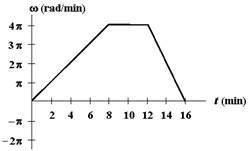Exhibit 12-1
The figure below shows a graph of angular velocity versus time for a woman bicycling around a circular track.
?

?
Use this exhibit to answer the following question(s).
Refer to . What is her angular displacement (in rad) in the 16-minute period shown in the graph?
a.
0
b.
16?
c.
32?
d.
40?
e.
64?
d
You might also like to view...
As an electron slows down from 0.9980c to 0.5000c, how much momentum does it lose?
(c = 3.0 × 108 m/s, melectron = 9.11 × 10-31 kg)
The wavelength of a wave is
A) how strong the wave is. B) the distance between a peak of the wave and the next trough. C) the distance between two adjacent peaks of the wave. D) the distance between where the wave is emitted and where it is absorbed. E) equal to the speed of the wave times the wave's frequency.
In order to understand the concept of temperature it is necessary to understand
a. the zeroth law of thermodynamics. b. the first law of thermodynamics. c. the second law of thermodynamics. d. all of the above. e. only (b) and (c) above.
When a rock is held above the ground, we say it has some potential energy. When we let it go, it falls and we say the potential energy is converted to kinetic energy. Finally, the rock hits the ground. What has happened to the energy?
A) The energy goes into the ground and, as a result, the orbit of the earth about the Sun is slightly changed. B) The energy goes to producing sound and to heating the ground, rock, and surrounding air. C) The rock keeps the energy inside it (saving it for later use). D) It is lost forever. Energy does not have to be conserved. E) It is transformed back into gravitational potential energy.